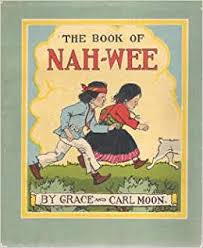Carl Moon
Listen to the Recess! Clip
| Author | Rita Smith |
| Air Date | 10/6/2004 |

Carl Moon Transcript
As a young boy growing up in Wilmington, Ohio, Carl Moon loved to read stories about Native Americans of the western United States and when he was still quite young he made up his mind to go West as soon as he grew up. After a photographic apprenticeship in Cincinnati, he did just that, leaving the Midwest and establishing a private studio in Albuquerque.
Before he got around to writing and illustrating children’s books, he photographed and painted many members of the Pueblo tribe who came into Albuquerque to sell their deerskins, beads and pottery. In 1907 his work was exhibited at the White House at the request of President Theodore Roosevelt. He also spent seven years gathering paintings and photographs for the Fred Harvey Headquarters, a business located near the Grand Canyon engaged in collecting and selling all things Indian.
This last work provided Moon and his wife, Grace, with the opportunity to travel widely through Arizona, New Mexico, Utah and Colorado. During these journeys, they heard many stories and legends of the native people and it was an easy task to write them down. Indian Legends in Rhyme, their first publication for children, was published in 1917. Grace wrote the story poems and Carl illustrated them. They collaborated on one more book, Lost Indian Magic, before they decided to each write their own stories, but Carl illustrated all the books Grace wrote as well as the ones he wrote himself.
Moon’s color illustrations made from his oil paintings utilize a warm Southwestern palette of red, brown, yellow, purple and sage. The paintings and his smaller pen and ink drawings both portray the deserts, mountains and canyons of Native American lands and the activities and ceremonies of the Indian people, in a finely detailed and charming style. His black and white photographs are also used to illustrate the children’s books, but no matter which media Moon chose to use, they all reveal his intimate acquaintance with and admiration of Native Americans.
Many of the books and stories Moon read as a child portrayed Native Americans as savages, cruel and ignorant, and emphasized the bravery of the white men who fought the Indians, but Moon knew early on that instead of hunting Indians with a gun and bowie knife, as his story book heroes always did, he wanted to honor them with a camera, paint brushes, and a writing pad. And his goal, in both his stories and illustrations, was to give the children back East a realistic portrait of the western Indian, especially the Indian child.
Sources:
Junior Book of Authors. Kunitz, Stanley J. and Howard Haycraft, eds. New York: H. W. Wilson Company, 1940. p. 262-3.
Something About the Author. Anne Commire, ed. Detroit: Gale Research Company, 1981. Vol. 25, p. 182-4.